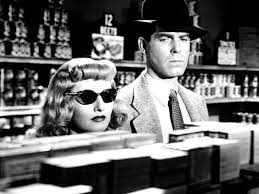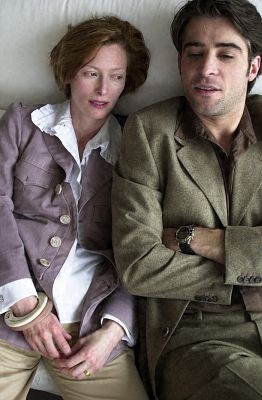by Katharine Elizabeth Monahan Huntley

Frank Capra’s Arsenic and Old Lace “. . . is a Halloween tale of Brooklyn, where anything can happen and it usually does.” Mortimer Brewster, dramatic critic and main character, finds himself in the situation (mc domain-universe) of “The guy who wrote the bachelor’s bible finally getting hooked himself.” Standing in line to obtain (relationship story concern) his and his intended’s (Elaine Harper, the influence character) marriage license, he attempts to avoid (mc solution) publicity by whispering: “I don’t want this to get out for a while” to the court clerk (mc thematic issue of delay), and dodging photographers by wearing dark “cheaters” and ducking (mc approach-doer) into a telephone booth.
Exasperated by the problems this endeavor (rs domain-physics) has created, Mortimer sounds off to Elaine: “Don’t you understand (rs signpost 1)? How could I marry you? Me, the symbol of bachelorhood! (rs thematic issue of self interest) I’ve sneered at every love scene in every play! I’ve written four million words against marriage! Now I’ll be hooked to a minister’s daughter (rs thematic counterpoint-morality)! . . . I won’t go through with it and that’s that (rs inhibitor-commitment)!” Elaine, dewy-eyed faithfulness (rs response), patiently waits out his tirade and they go on to get hitched.
The newlyweds taxi over to the Brewster sisters’ house. Elaine is the proverbial girl next door, having grown up in the parsonage next to Mortimer’s maiden aunts (“they’re like pressed rose leaves”). The young couple’s intention is to announce the marriage to their respective relatives, then set off for a honeymoon in Niagara Falls. Meanwhile, the aunts and Reverend Harper are taking tea, discussing Mortimer and Elaine’s relationship. Reverend Harper voices his disapproval of Mortimer’s book, Marriage: A Fraud and a Failure: “No man with this published attitude on marriage should take any man’s daughter any place, anytime.” (mc symptom-oppose)
Reverend Harper departs. Mortimer enters and reveals his newlywed status to Aunt Abby and Aunt Martha. They are thrilled, as this is what they had hoped (ic thematic issue) for Elaine and their nephew all along. When Mortimer asks for the hidden notes on his forthcoming novel, Mind over Marriage, the critic’s concern for his future indicates conflict between private and public persona—yes he may be a married man, at least on paper, but in the eyes of the public he is the quintessential bachelor. In the search, Mortimer discovers a dead body in the window seat (story driver-action). Further, his aunts are the ones responsible (os catalyst) for killing him and a dozen or so others with kindness in the form of arsenic in elderberry wine. From this point on the objective story is emphasized, particularly in the storytelling, to the near exclusion of the main character, influence character, and relationship story throughlines.
The objective story domain is psychology, and the characters’ different ways of thinking are what causes problems. “Charge” is the battle cry of Mortimer’s brother, believing himself to be Teddy Roosevelt. Long lost other brother Jonathan is a psychopath with a cold body of his own and no qualms about rubbing out immediate family. Aunt Abby and Aunt Martha’s pursuit (os problem) of lonely old gentlemen to poison (“Murder Incorporated”), thinking it the charitable thing to do, is a dilemma—Mortimer scolds: “I don’t know how I can explain this to you, but it’s not only against the law, it’s wrong! It’s not a nice thing to do! People wouldn’t understand. . . . this is developing into a very bad habit!”
The story goal of becoming is somewhat nebulous, however, becoming as an objective story concern is quite evident. Elaine becoming part of a wacky family: “You wouldn’t want to set up housekeeping in a padded cell . . . insanity runs in my family—it practically gallops!”—Jonathan becoming the “prodigal son”—his Boris Karloff countenance undergoing a physical transformation at the tremulous hands of Dr. Einstein–the burly cop on the beat becoming a playwright, and so forth. The thematic conflict of commitment vs. responsibility is also quite marked. O’Hara takes over Officer Brophy’s responsibilities for protecting the neighborhood, a nephew’s responsibilities to his family take precedence over the commitment to a new bride, much discussion is given to committing Teddy to Happydale.
“Egads!” Mortimer comes across a new body (Jonathan’s victim) in the window seat and demands an explanation from Aunt Abby. She’s outraged: “It’s a stranger. . . . It’s getting so anybody thinks he can walk in this house . . . That man’s an impostor! And if he came here to be buried in our cellar he’s mistaken!” Mortimer is exasperated: “Aunt Abby how can I believe you!” (os symptom-disbelief) He feels he must prevent (os solution) his aunts from becoming Sing Sing inmates for their well-intentioned misdeeds. He takes the necessary steps (mc mental sex-male) to commit Teddy sooner than originally planned. Mortimer’s thinking is, if anyone becomes wise to the bodies buried down in Panama (the cellar), Teddy can take the rap “. . . everybody knows he’s crazy.”
The nocturnal activities of Jonathan and his henchman, weaselly Dr. Einstein, skulking about with their body (Mr. Spinoza), and the aunt’s fussy preparations to hold funeral services for their murder victim (Mr. Hoskins), not to mention a near hysteric Elaine running in and out of the household (ic benchmark of preconscious) alerts Officer O’Hara. He stops in—but instead of clueing into how things are going (forewarning of progress), he pitches his play to Mortimer (os inhibitor of self-interest). Madness, mayhem, double takes and pratfalls continue until Teddy’s blasted bugle brings in Lieutenant Rooney.
Temporary sanity sorts out the confusion—Jonathan is carted off by New York’s finest—Mr. Witherspoon packs up Teddy’s duffel for Happydale (after pitching his play to the dramatic critic)—Aunt Abby and Aunt Martha avoid the slammer by committing themselves as well, but not before letting Mortimer in on a family secret. He is not really a Brewster, but the “son of sea cook”—a happy fact he shouts to the world as he kisses his wife for all to see (mc resolve-change) and starts (mc growth) his happily ever after (outcome-success; story judgment-good).
Postscript: I once spotted Abe Vigoda “Fish” at Diablo Valley College “The Rock.” His nephew was in a school play.





